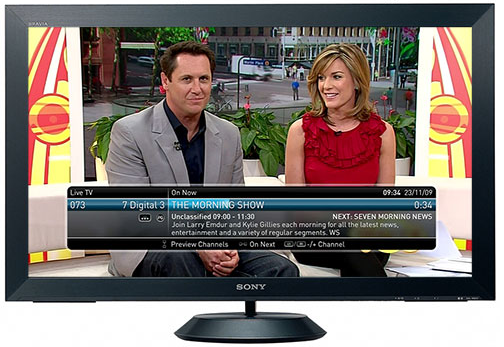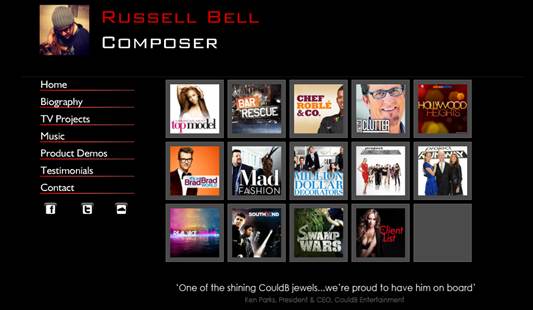AUDIO HAS PROBABLY the widest appeal of any stock material after photos, and can be
used in any context from a major movie studio trailer to the backing track of a
podcast. The proliferation of digital TV channels and ever-decreasing budgets
for small-screen commissions means there’s a bigger and more accessible market
than ever before for stock music. And, paralleling the rise of digital
photography, thanks to the falling cost of home recording equipment, there’s
never been more music available to meet the demand.

Widescreen
16:9 Digital TV viewed on Sony Bravia TV
From the buyer’s perspective, if you need
music for a project there’s no shortage online. You pays your money and you
takes your choice. Do make sure the licence supplied with your purchase covers
the track’s intended usage; it’s not always quite as simple as with
royalty-free stock images. Reputable libraries will have an FAQ page which
covers licensing. If the licence terms aren’t explicitly laid out, steer clear,
because any misunderstandings (or, in the worst case, buying from a dodgy
supplier) could create big problems for you in the future.
Many sites price ‘horses for courses’, as
with video. Taking Revostock as an example. If you’re using a clip as
background music for a corporate presentation or any other not-for-profit
production, you need only purchase the ‘standard’ licence, costing $15-$30 per
track. A ‘wider’ licence covers limited broadcast rights and reproduction. The
most comprehensive ‘wide’ licence (typically at two to four times the cost of
standard) includes all broadcast and reproduction likelihoods.
Of course, as long as you’ve properly
licensed it, you can use stock within compositions that you’re exploiting
commercially. As with other stock, though, it’s very rare that any music
supplier would allow you to resell their product as your own or make it
available in isolation in a developed product – for example, using a stock
music drum loop in an iPad music app. Scrutinise the terms and conditions of
your licence and if you’re unsure, contact the site directly, explaining your
intended usage.
For sellers, as with other forms of stock,
you’ll only compete effectively if you research the market. If you can be
flexible in terms of genre, it’s worth keeping abreast of musical styles that
are currently on trend and upcoming. Try to stay ahead of the curve by
listening to the music that smaller companies use on their adverts and shows.
Often it’s the boutique agencies, pedaling more niche products that will take a
risk by using less familiar material in their advertising.
Don’t forget most campaigns are planned
months in advance, so what you’re hearing on TV may very well already be out of
fashion by the time it’s broadcast. That said, there are certain styles that
always seem to be in demand. Big orchestral trailer cues, meditative piano solos
and quirky plucked-string ‘Dramedy’ cues will always have their uses, so if you
can handle churning out those derivative styles then you’ll find a market for
them, albeit a pretty saturated one.
World celebrations and events can be
planned for. For example, the Olympics saw a slew of epic motivational cues
hitting the sales charts. Target regular demands by writing and releasing
appropriately themed tracks ahead of Christmas, Valentine’s Day and other
annual celebrations.
Amid all this commercial thinking, of
course, raises the question of artistic creativity. Stock music, like
photography or illustration, can be a casual sideline, but if you want to make
a living from it, you can forget about being an artist for 90% of the time.
Your music is your business, and as in any other business you’ll need to cater
to your market to succeed. If your musical style is unusual enough to carve its
own niche, you may find buyers who are willing to take a chance on your
individual approach – but that’s not usually what stock is about. Almost by
definition, stock is somewhat generic. So you should plan the style. Length,
instrumentation ad format of your music carefully to fit the market you’re
looking to sell to.
BEFORE THE INTERNET, you might have submitted your music to a library publisher who
would press and sell CDs. Nowadays, you upload it to royalty-free stock sites
that will host, list and distribute it for a percentage of the sale price.
There are many different business models. With variable commission splits and back-end
broadcast rights. The main thing to decide when choosing a publishing route is
whether you’d rather earn money for each downloaded track – essentially the
same model as royalty-free photography – or you’d prefer to register your music
with the PRS so that receive broadcasting royalties when the music is used.

Buy
and sell royalty-free stock photos on Fotolia
AudioJungle, for example, won’t allow you
to sell PRS registered tracks, whereas Revostock will produce a cue sheet for
the broadcaster with all the information they need to pay the correct
performance fees. This is explained at bit.ly/SKoqHh.
If photographers and illustrators are
sometimes sceptical about microstock, be aware that people in the music
industry can be downright snobbish about music micropayment sites. Mass-market
royalty-free sites like AudioJungle and AudioMicro are considered by some to
devalue stock music, and if you sell through them you may be setting the wrong
tone for your CV. Larger production music companies have been known to flat-out
refuse to deal with composers associated with such sites. Don’t be put off if
you think it’s the right route for you, but be aware that it may be an issue.
Besides music, another potentially
lucrative avenue is sample and sound effects (fx) creation. Many of the sites
we’ve mentioned also sell fx, as do Productiontrax and AudioSparx. The sale
price for an effect can be just pennies, but if you’re charging for each bleep
and bloop, the monthly returns add up.
Selling your fx as packs enables you to
charge more gives game developers, for example, a themed set of sounds to work
with, which they often prefer. (Music can also be bundled with alternative
versions or ‘stems’ to make a pack that will save scorers time.) Making drum
loops, synth patches and other samples for composers to use in their own
productions can also be a -money-spinner through websites like Sampleism and
Audiobase. They handle the financials and distribution, leaving you free to
concentrate on the creative side, uploading content direct to the sites. Again,
a 50% commission rate seems to be the standard cut.
As with image sales, you’ll only sell work
on a stock site if potential buyers can find it. Appropriate titles, tagging
and metadata are essential. Russell Bell (russellbellmusic.com) advices sellers
to be crafty with their tagging. ‘Visit all the biggest-selling tracks on a
site for a listen, then read the tags they’ve used. If a track is selling 50
copies a month, there must be a reason. Yes, the music is good, cutting-edge
and relevant, but it can help if you do hit certain keywords.’

Website:
russellbellmusic.com
There are no simple rules, says Bell, ‘but
don’t waste your allotted words by describing the cue in an awkward fashion. If
it’s a big trailer cue, state all the words you would use yourself to find that
cue. It’s epic, orchestral, action, driven, loud, movie, trailer, pursuit,
chase, angry, mad, choir, and so on.
Titles are of particular importance to audio.
‘If it has a certain feel to it, try and name the track so that it tells the
story in a few words. For a busy action cue you might use the title “Ready to
go” or “Night pursuit”. Naming it “Go” or “Epic track 1” tells no-one anything
at all. If it’s anxious and pacy, how about “Watching the Clock”?’
Be aware of your audience. Sites like
AudioJungle can attract buyers with less experience and sophistication, so Bell
suggests ‘dumbed-down’ titles to draw in more searches. ‘The downside to this
is that you can find your music swimming in a pool of a thousand cues all
roughly called “Ukulele Advert” or something similar!’ Striking a balance
between the obvious and the distinctive should be your aim and that’s as good a
summary as any of the whole field old stock sales.